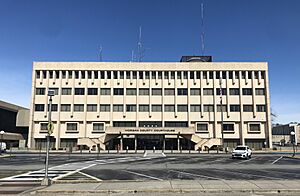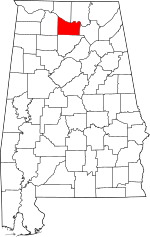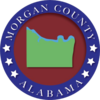Morgan County, Alabama facts for kids
Quick facts for kids
Morgan County
|
||
|---|---|---|

Morgan County Courthouse in Decatur
|
||
|
||

Location within the U.S. state of Alabama
|
||
 Alabama's location within the U.S. |
||
| Country | ||
| State | ||
| Founded | February 6, 1818 | |
| Named for | Daniel Morgan | |
| Seat | Decatur | |
| Largest city | Decatur | |
| Area | ||
| • Total | 599 sq mi (1,550 km2) | |
| • Land | 579 sq mi (1,500 km2) | |
| • Water | 20 sq mi (50 km2) 3.3% | |
| Population
(2020)
|
||
| • Total | 123,421 | |
| • Estimate
(2023)
|
125,133 |
|
| • Density | 206.05/sq mi (79.55/km2) | |
| Time zone | UTC−6 (Central) | |
| • Summer (DST) | UTC−5 (CDT) | |
| Congressional district | 5th | |
|
||
Morgan County is a special area in the north-central part of Alabama, a state in the United States. It's like a big neighborhood with its own government. In 2020, about 123,421 people lived here. The main town, or "county seat," where the county government is located, is Decatur.
The county was first called Cotaco County. But on June 14, 1821, its name was changed. It was renamed to honor Daniel Morgan, a brave general from Virginia who fought in the American Revolutionary War. Morgan County is part of the larger Decatur Metropolitan Area. It also connects to the Huntsville area.
Contents
History of Morgan County
Morgan County was created a long time ago. The government of the Alabama Territory formed it on February 6, 1818. This land was originally acquired from the Cherokee people through a special agreement called the Treaty of Turkeytown. At first, the county was known as Cotaco County.
Geography of Morgan County
Morgan County covers a total area of about 599 square miles. Imagine a square that's about 24 miles on each side! Most of this area is land, but about 20 square miles (which is 3.3% of the total) is covered by water.
Important River
Neighboring Counties
Morgan County shares its borders with several other counties:
- Madison County (to the northeast)
- Marshall County (to the east)
- Cullman County (to the south)
- Lawrence County (to the west)
- Limestone County (to the northwest)
Protected Natural Areas
Part of the Wheeler National Wildlife Refuge is located in Morgan County. This is a special place where nature is protected, and animals can live safely.
Population and People
| Historical population | |||
|---|---|---|---|
| Census | Pop. | %± | |
| 1820 | 5,263 | — | |
| 1830 | 9,062 | 72.2% | |
| 1840 | 9,841 | 8.6% | |
| 1850 | 10,125 | 2.9% | |
| 1860 | 11,335 | 12.0% | |
| 1870 | 12,187 | 7.5% | |
| 1880 | 16,428 | 34.8% | |
| 1890 | 24,089 | 46.6% | |
| 1900 | 28,820 | 19.6% | |
| 1910 | 33,781 | 17.2% | |
| 1920 | 40,196 | 19.0% | |
| 1930 | 46,176 | 14.9% | |
| 1940 | 48,148 | 4.3% | |
| 1950 | 52,924 | 9.9% | |
| 1960 | 60,454 | 14.2% | |
| 1970 | 77,306 | 27.9% | |
| 1980 | 90,231 | 16.7% | |
| 1990 | 100,043 | 10.9% | |
| 2000 | 111,064 | 11.0% | |
| 2010 | 119,490 | 7.6% | |
| 2020 | 123,421 | 3.3% | |
| 2023 (est.) | 125,133 | 4.7% | |
| U.S. Decennial Census 1790–1960 1900–1990 1990–2000 2010–2020 |
|||
The population of Morgan County has grown a lot over the years. In 2020, there were 123,421 people living here. People of many different backgrounds call Morgan County home. About 71% of the people are White, and about 12% are Black or African American. Around 10% of the population is Hispanic or Latino.
In 2010, the average age of people in Morgan County was 39 years old. About 24% of the people were under 18. Families living together made up a big part of the households.
Getting Around: Transportation
Major Roads
Many important roads help people travel through Morgan County:
Train Lines
Two major train companies, CSX Transportation and Norfolk Southern Railway, have lines that run through Morgan County.
Towns and Communities
Morgan County has several cities, towns, and smaller communities where people live.
Cities
- Decatur (This is the county seat, meaning it's where the main county offices are. Part of Decatur is also in Limestone County.)
- Hartselle
- Huntsville (Most of Huntsville is in Madison County, but a small part is in Morgan County.)
Towns
Smaller Communities
These are areas that are not officially cities or towns, but still have people living there:
- Basham
- Brooksville
- Burningtree Mountain
- Danville
- Hulaco
- Lacey's Spring
- Massey
- Morgan City (partly in Marshall County)
- Moulton Heights
- Neel
- Pence
- Ryan Crossroads
- Six Mile
- Six Way
- Union Hill
- Valhermoso Springs
- Woodland Mills
Past Cities and Towns
Some places that used to be official cities or towns in Morgan County are now part of other areas or no longer exist as separate entities.
- Albany/New Decatur (This city later became part of Decatur.)
- Austinville
- Cedar Lake
Ghost Town
- Lacon (A ghost town is a place that used to be a town but is now mostly empty.)
Education in Morgan County
Students in Morgan County attend schools that are part of different school districts:
- Decatur City School District
- Hartselle City School District
- Morgan County School District
See also
 In Spanish: Condado de Morgan (Alabama) para niños
In Spanish: Condado de Morgan (Alabama) para niños


